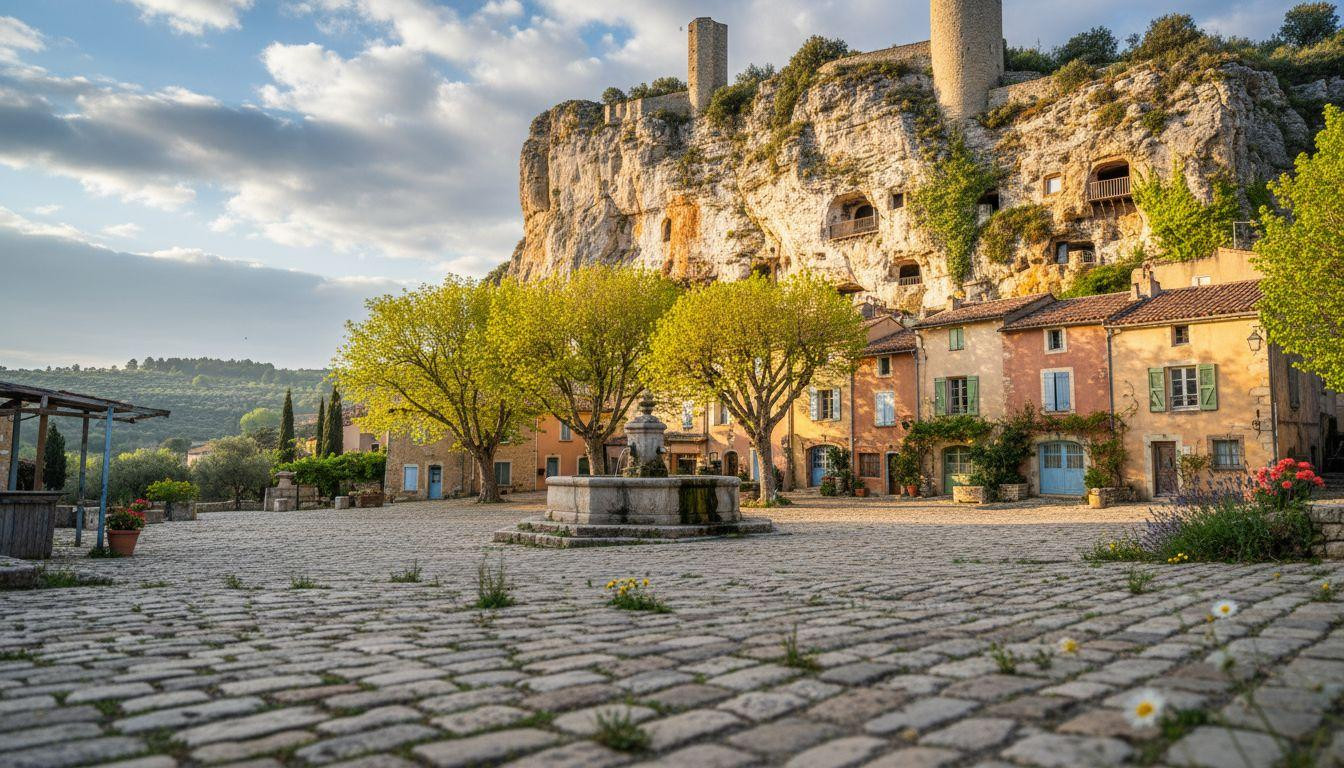This Provençal village where morning light transforms 262-foot limestone cliffs into glowing amber lanterns. Cotignac sits beneath towering tufa rock formations that catch sunrise at precisely the angle needed to illuminate ochre houses below. Ancient troglodyte caves darken like shadowed eyes as golden light spreads across stone facades. The 2,200 residents of this Plus Beaux Villages commune wake each day to geological theater.
Located 56 miles northwest of Marseille, Cotignac offers authentic Provence without lavender-field crowds. Spring brings comfortable temperatures between 59-72°F. The village earned its prestigious label in 2023.
Where limestone becomes architecture
The tufa cliff rises 262 feet above village rooftops. This porous limestone formed over millennia from calcium carbonate deposits left by ancient mineral springs. The River Cassolle once cascaded over these rocks before being diverted east in the 14th century.
Troglodyte dwellings carved into the cliff face remain inhabited today. These cave homes protected residents during medieval invasions and Saracen raids. Medieval towers crown the cliff top, their stone foundations dating to the 12th century.
Eighteen drinking fountains dot the village streets, most built during the 17th century. Fresh mountain water flows from ancient sources. The market square spreads beneath towering plane trees, their shade protecting historic cobblestones and morning vendors.
The light that changes stone
Morning transformation
Sunrise occurs at 5:55 AM during June’s peak season. The cliff’s eastward orientation catches low-angle morning light between 15-25 degrees above the horizon. Iron oxide deposits in the limestone create distinctive amber wavelengths when illuminated.
Best viewing occurs April through June when sun angles optimize the glow effect. The phenomenon lasts 15-25 minutes after sunrise. Clear weather intensifies colors while light cloud cover creates softer diffusion.
Living history in caves
Approximately 15-20 cave dwellings remain actively inhabited, not preserved as museums. Original excavations date to the 12th-14th centuries, not the 4th century claimed by some guides. Residents carved these chambers for protection during invasions.
Notre-Dame de Grâces pilgrimage site attracts 120,000 visitors annually. The sanctuary honors recognized religious miracles involving the Virgin Mary and Saint Joseph. Medieval architecture combines with spiritual significance throughout the village.
Beyond the postcard moment
Tuesday market reality
Local produce fills 70% of market stalls from 8 AM-1 PM each Tuesday. Authentic vendors sell quince preserves, olive oils, and seasonal vegetables. Ceramic workshops operate year-round using local clay deposits discovered centuries ago.
The annual Quince Festival occurs October 18-19, 2025. Local producers demonstrate traditional preservation techniques. Wine tastings feature regional rosé varieties for $17-22 per session.
Access without crowds
Marseille airport connects via 55-mile drive taking 1 hour 15 minutes. Route A8 to exit 35, then D560 to D7 provides direct access. Free parking eliminates the $13-17 daily fees charged in nearby tourist villages.
Annual visitor count reaches 185,000 compared to Roussillon’s 550,000 and Gordes’ 700,000. Dramatic cliff formations rival international destinations without overwhelming crowds. Accommodation costs $105-170 nightly versus $160-250 in heavily touristed alternatives.
The silence returns
Late afternoon light shifts from amber to rose gold across cliff faces. Residents return from olive groves and vineyard work. Cave openings fill with deep shadows as evening approaches.
Market vendors pack away unsold produce. Fountains continue their centuries-old flow through empty squares. Tomorrow brings another sunrise at 5:55 AM. The tufa cliff waits in evening calm, ready for morning’s golden transformation.
Your questions about Cotignac answered
When should I visit for the best light show?
April through June offers optimal morning light angles with comfortable 59-72°F temperatures. Sunrise occurs earliest June 15 at 5:55 AM. Clear weather intensifies the amber glow effect. Avoid July-August crowds despite continued light phenomenon.
How long should I stay to experience everything?
Two to three days allows time for morning photography, cave exploration, market visits, and wine tasting. Day trips from Marseille feel rushed given the 1 hour 15 minute drive each way. Combine with Verdon Gorge visits 28 miles north for extended itineraries.
What are the real costs compared to famous Provence villages?
Accommodation averages $105-170 nightly versus $160-195 in Roussillon and $180-250 in Gordes. Meals cost $13-28 per person at local bistros. Troglodyte cave tours charge just $2 per person. Free parking saves $13-17 daily compared to tourist destinations.
Morning light fades from cliff faces as shadows lengthen across cobblestone streets. Ancient fountains echo through emptying squares. The amber glow will return tomorrow at sunrise, transforming limestone into living lanterns once again.
